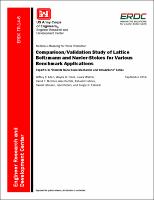Please use this identifier to cite or link to this item:
https://hdl.handle.net/11681/8483Full metadata record
| DC Field | Value | Language |
|---|---|---|
| dc.contributor | University of Akron. Department of Mechanical Engineering | - |
| dc.contributor | Information Technology Laboratory (U.S.) | - |
| dc.contributor | Coastal and Hydraulics Laboratory (U.S.) | - |
| dc.contributor.author | Allen, Jeffrey B. | - |
| dc.contributor.author | Hodo, Wayne D. | - |
| dc.contributor.author | Walizer, Laura E. | - |
| dc.contributor.author | McInnis, David P. | - |
| dc.contributor.author | Carrillo, Alejandro R. | - |
| dc.contributor.author | Jelinek, Bohumir, 1974- | - |
| dc.contributor.author | Johnson, Daniel J. | - |
| dc.contributor.author | Peters, John F. | - |
| dc.contributor.author | Felicelli, Sergio D. | - |
| dc.creator | Mississippi State University. Center for Advanced Vehicular Systems | - |
| dc.date.accessioned | 2016-06-20T13:27:12Z | - |
| dc.date.available | 2016-06-20T13:27:12Z | - |
| dc.date.issued | 2014-09 | - |
| dc.identifier.uri | http://hdl.handle.net/11681/8483 | - |
| dc.description | Technical Report | - |
| dc.description | Abstract: For purposes relating to the U.S. Army’s need for materials modeling and force protection, this work provides justification for assigning effective equivalence between two commonly used fluid simulation methods—namely the Navier-Stokes (NS) and Lattice Boltzmann methods. The Lattice Boltzmann Method (LBM) has become increasingly popular as an alternative approach to traditional NS-based techniques for modeling various incompressible fluid flow applications. The LBM has recently increased its range of applicability to include numerous fields of interest including those involving multiphase and thermo-fluid structure interactions. This report documents a comparison/validation effort accompanying the development of a standard Lattice Boltzmann solver with immersible moving boundaries. The primary goal is to validate the model by comparing it with various laminar, incompressible flow cases simulated using a finite volume-based NS solver. Simulations involving four standard benchmark studies were analyzed: (1.) the flow through a rectangular channel, (2.) the flow through a lid-driven cavity, (3.) the flow over a back-step, and (4.) the flow over a stationary circular cylinder. For the specific applications and Reynolds numbers simulated, the results showed excellent agreement between the two cases. Disparities were observed only when the theoretical constraints of the LBM were exceeded. | - |
| dc.publisher | Geotechnical and Structures Laboratory (U.S.) | - |
| dc.publisher | Engineer Research and Development Center (U.S.) | - |
| dc.relation | http://acwc.sdp.sirsi.net/client/en_US/search/asset/1040260 | - |
| dc.relation.ispartofseries | ERDC TR ; 14-6. | - |
| dc.rights | Approved for public release; distribution is unlimited. | - |
| dc.source | This Digital Resource was created in Microsoft Word and Adobe Acrobat | - |
| dc.subject | Lattice-Boltzmann Method (LBM) | - |
| dc.subject | Navier-Stokes | - |
| dc.subject | Numerical models | - |
| dc.subject | Mathematical models | - |
| dc.subject | Modeling | - |
| dc.subject | Incompressible fluid flow | - |
| dc.subject | Immersible moving boundary (IMB) | - |
| dc.subject | Channel flow | - |
| dc.subject | Reynolds number | - |
| dc.subject | Materials Modeling for Force Protection (U.S.) | - |
| dc.title | Comparison/Validation Study of Lattice Boltzmann and Navier Stokes for Various Benchmark Applications: Report 1 in “Discrete Nano-Scale Mechanics and Simulations” Series | - |
| dc.type | Report | en_US |
| Appears in Collections: | Technical Report | |
Files in This Item:
| File | Description | Size | Format | |
|---|---|---|---|---|
| ERDC-TR-14-6.pdf | 2.69 MB | Adobe PDF |  View/Open |